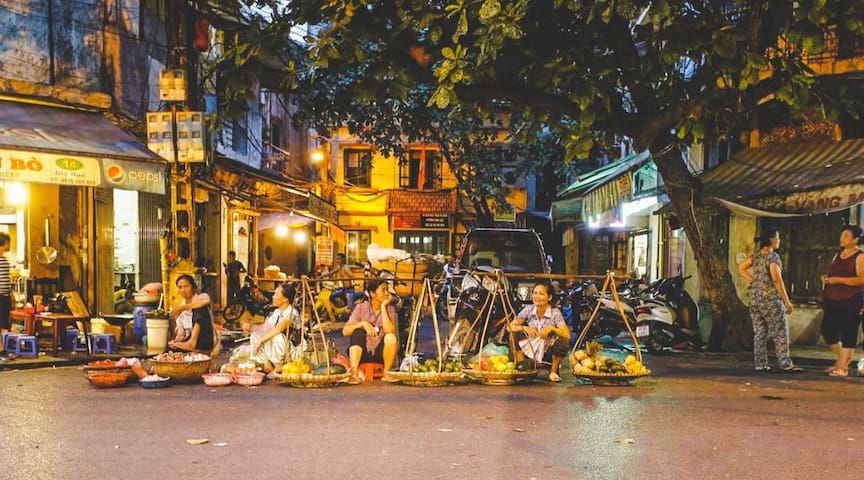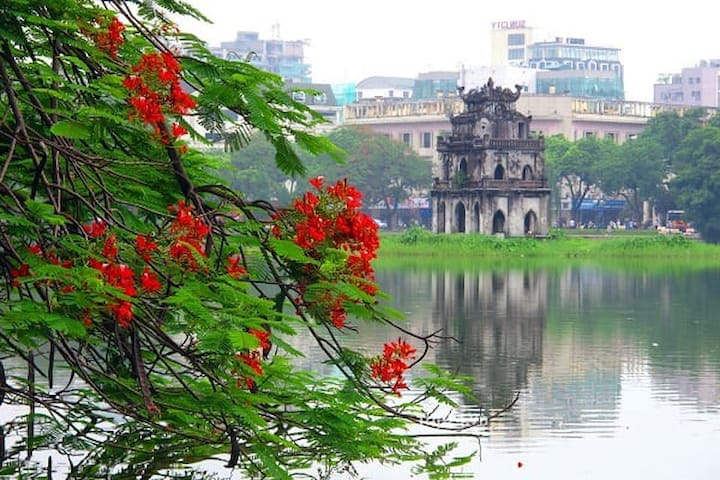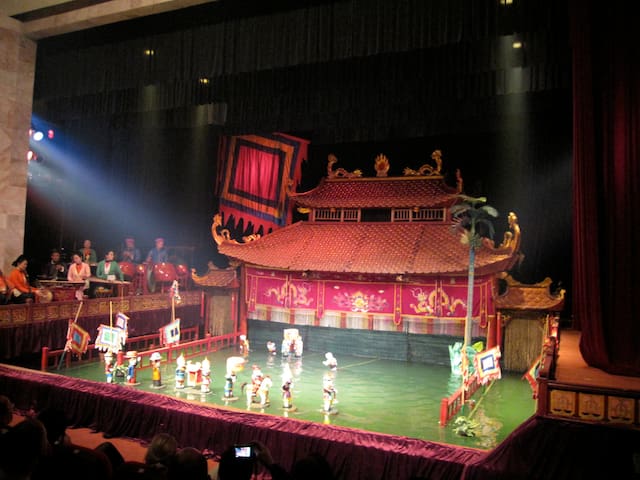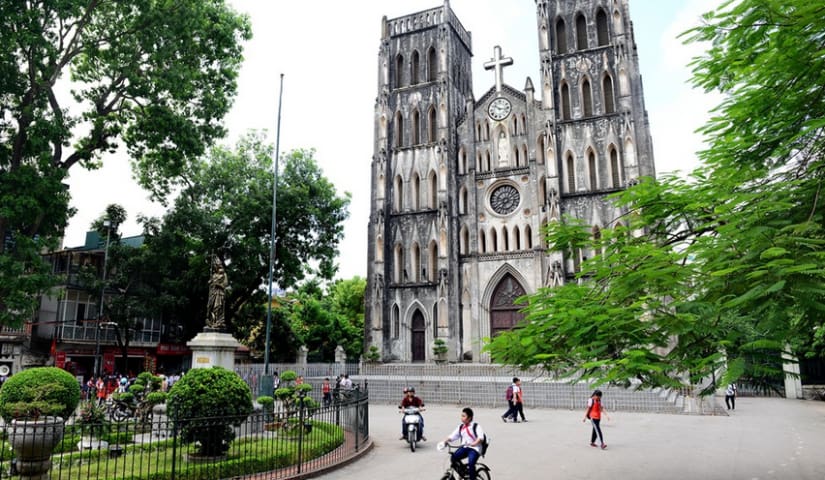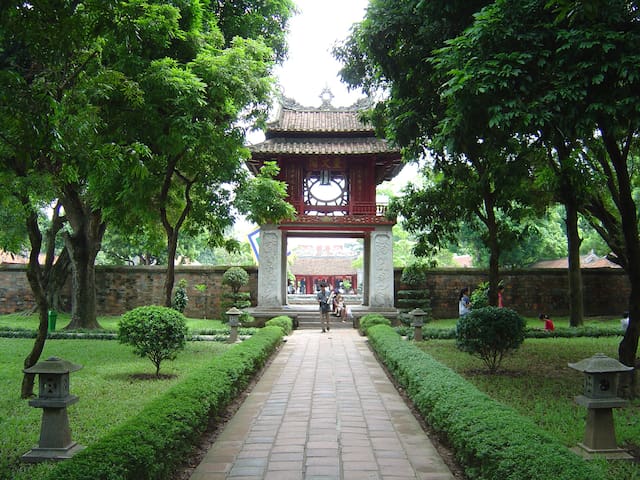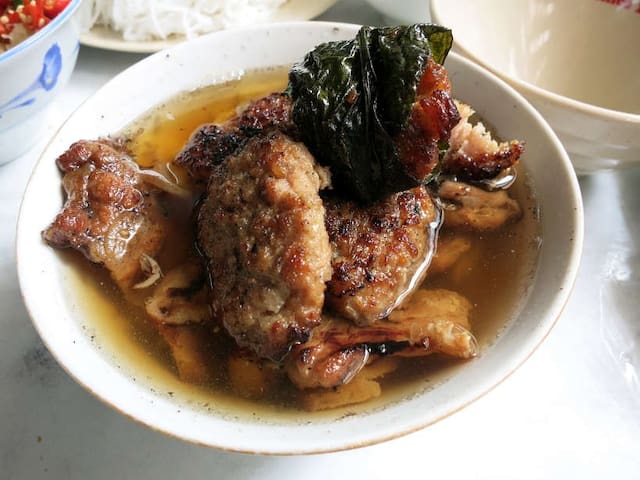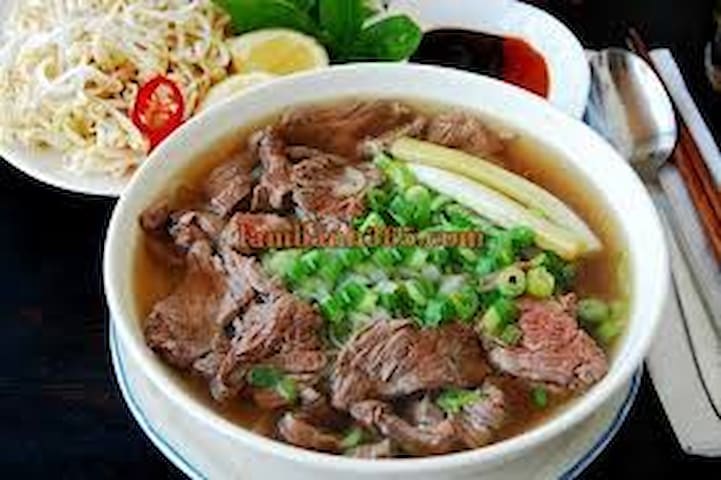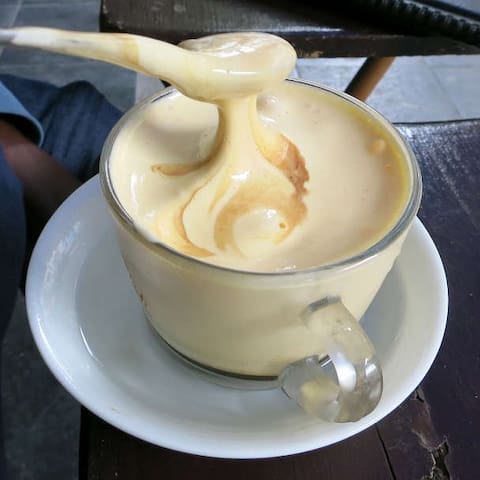Sightseeing
The Old Quarter (Vietnamese: Phố cổ Hà Nội) is the name commonly given to the historical civic urban core of Hanoi, located outside the Imperial Citadel of Thăng Long. This quarter used to be the residential, manufacturing and commercial center, where each street was specialized in one specific type of manufacturing or commerce.
Another common name referring to approximately the same area is the 36 streets (Vietnamese: Hà Nội 36 phố phường), after the 36 streets or guilds that used to make up the urban area of the city.
The official extent of the Hanoi Old Quarter has been fixed by a 1995 decision from the Vietnamese Ministry of Construction[1]: in the north it is limited by Hàng Đậu street, in the west by Phùng Hưng street, in the south by Hàng Bông street, Hàng Gai street, Cầu Gỗ street, and Hàng Thùng street, and in the east by Trần Quang Khải street and Trần Nhật Duật street. Several of the streets that were part of the historic urban area of Hanoi lie outside this region, which was determined for being most dense in historical streets and for having maintained its historical character best.
The official Old Quarter is part of the Hoàn Kiếm District. Its total area is about 100 ha and it counts 76 streets distributed over 10 wards.
The residential and commercial area that is now the Old Quarter came to be during the Lý and Trần dynasties and was then located east of the Imperial Citadel of Thăng Long and along the Red River. During the Lê dynasty, scholar Nguyễn Trãi already mentioned some of the areas each specialized in one particular trade. It was then surrounded by a defensive wall with several gates.
During the Lê dynasty, the area included several lakes and wetlands, the largest of which was Thái Cực lake. These lakes, as well as the Tô Lịch River were connected with Hoàn Kiếm lake and the Red River. Near the end of the 19th century these lakes and rivers became isolated from each other.
During the Lý and Trần dynasties, many people from the surrounding plains migrated to the city and settled in what is now the Old Quarter, creating the densest urban area of the city. The Lê dynasty period saw an additional influx of Chinese immigrants who arrived to trade, creating several Chinese neighbourhoods..
When the French ruled over Vietnam, they partially rebuilt the area. This period saw many French and Indians settling there to conduct business. Two small markets were demolished to make place for Đồng Xuân Market. Furthermore a tramway was constructed through the quarter.
The area is still the commercial heart of Hanoi.
The most famous trait of the Old Quarter are its areas dedicated to one specific trade or guild. Craftsmen from villages around the city used to gather in one area of their guild to sell their wares to merchants. The crafts or guilds of each area gave the names to the streets of the quarter, so that most streets acquired names starting with hàng ("wares"), such as Hàng Tre street ("bamboo wares street") and Hàng Đồng street ("copper wares street").
Several of the streets are still specialized in the trade that gave them their names. Others still specialize in one specific trade, but a different one from their traditional specialty — such as Hàng Buồm street ("sails street") which has become dominated by Vietnamese cakes and candy.
The Old Quarter has been shown by researchers using the quantitative social anthropology approach to have exhibited Hanoi's cultural evolution during the first decades of the 20th century.
The Old Quarter contains many historic sights, such as temples, pagodas, and assembly halls.
Most craft streets used to have a temple dedicated to worshiping mythical founders of the craft. Particular is that the ground floor of such communal temples in the Hanoi Old Quarter was often still used for commerce. With the passage of time, most such communal temples have been destroyed. Several temples have survived, such as the Mã Mây and Kim Cổ temples.
Several city gates were located in what is now the Old Quarter. Only the Quan Chưởng gate is still left
Characteristic of the Old Quarter is the ancient architecture of the commercial area. Most of the historic houses there are shophouses with slanted tile roofs, of which the side facing the street used to be used as entrance to the shop inside. Houses of this type were mostly built in the 18th and 19th centuries — before that most houses had thatched roofs.
Since the end of the 20th century, the number of traditional houses have been dwindling in number.
Many of the historic remnants of the Old Quarter have deteriorated and are in need of restoration. For the 1000th anniversary of Nội in 2010, the Hanoi People's Committee decided to spend 50 billion VND on the refurbishing of 75 streets inside and outside the Old Quarter, among others for applying lime to restore the yellow color of façades in the Old Quarter.[3] Process has been criticised for having been executed carelessly, leading to a less than optimal result.
31 locals recommend
Hanoi
The Old Quarter (Vietnamese: Phố cổ Hà Nội) is the name commonly given to the historical civic urban core of Hanoi, located outside the Imperial Citadel of Thăng Long. This quarter used to be the residential, manufacturing and commercial center, where each street was specialized in one specific type of manufacturing or commerce.
Another common name referring to approximately the same area is the 36 streets (Vietnamese: Hà Nội 36 phố phường), after the 36 streets or guilds that used to make up the urban area of the city.
The official extent of the Hanoi Old Quarter has been fixed by a 1995 decision from the Vietnamese Ministry of Construction[1]: in the north it is limited by Hàng Đậu street, in the west by Phùng Hưng street, in the south by Hàng Bông street, Hàng Gai street, Cầu Gỗ street, and Hàng Thùng street, and in the east by Trần Quang Khải street and Trần Nhật Duật street. Several of the streets that were part of the historic urban area of Hanoi lie outside this region, which was determined for being most dense in historical streets and for having maintained its historical character best.
The official Old Quarter is part of the Hoàn Kiếm District. Its total area is about 100 ha and it counts 76 streets distributed over 10 wards.
The residential and commercial area that is now the Old Quarter came to be during the Lý and Trần dynasties and was then located east of the Imperial Citadel of Thăng Long and along the Red River. During the Lê dynasty, scholar Nguyễn Trãi already mentioned some of the areas each specialized in one particular trade. It was then surrounded by a defensive wall with several gates.
During the Lê dynasty, the area included several lakes and wetlands, the largest of which was Thái Cực lake. These lakes, as well as the Tô Lịch River were connected with Hoàn Kiếm lake and the Red River. Near the end of the 19th century these lakes and rivers became isolated from each other.
During the Lý and Trần dynasties, many people from the surrounding plains migrated to the city and settled in what is now the Old Quarter, creating the densest urban area of the city. The Lê dynasty period saw an additional influx of Chinese immigrants who arrived to trade, creating several Chinese neighbourhoods..
When the French ruled over Vietnam, they partially rebuilt the area. This period saw many French and Indians settling there to conduct business. Two small markets were demolished to make place for Đồng Xuân Market. Furthermore a tramway was constructed through the quarter.
The area is still the commercial heart of Hanoi.
The most famous trait of the Old Quarter are its areas dedicated to one specific trade or guild. Craftsmen from villages around the city used to gather in one area of their guild to sell their wares to merchants. The crafts or guilds of each area gave the names to the streets of the quarter, so that most streets acquired names starting with hàng ("wares"), such as Hàng Tre street ("bamboo wares street") and Hàng Đồng street ("copper wares street").
Several of the streets are still specialized in the trade that gave them their names. Others still specialize in one specific trade, but a different one from their traditional specialty — such as Hàng Buồm street ("sails street") which has become dominated by Vietnamese cakes and candy.
The Old Quarter has been shown by researchers using the quantitative social anthropology approach to have exhibited Hanoi's cultural evolution during the first decades of the 20th century.
The Old Quarter contains many historic sights, such as temples, pagodas, and assembly halls.
Most craft streets used to have a temple dedicated to worshiping mythical founders of the craft. Particular is that the ground floor of such communal temples in the Hanoi Old Quarter was often still used for commerce. With the passage of time, most such communal temples have been destroyed. Several temples have survived, such as the Mã Mây and Kim Cổ temples.
Several city gates were located in what is now the Old Quarter. Only the Quan Chưởng gate is still left
Characteristic of the Old Quarter is the ancient architecture of the commercial area. Most of the historic houses there are shophouses with slanted tile roofs, of which the side facing the street used to be used as entrance to the shop inside. Houses of this type were mostly built in the 18th and 19th centuries — before that most houses had thatched roofs.
Since the end of the 20th century, the number of traditional houses have been dwindling in number.
Many of the historic remnants of the Old Quarter have deteriorated and are in need of restoration. For the 1000th anniversary of Nội in 2010, the Hanoi People's Committee decided to spend 50 billion VND on the refurbishing of 75 streets inside and outside the Old Quarter, among others for applying lime to restore the yellow color of façades in the Old Quarter.[3] Process has been criticised for having been executed carelessly, leading to a less than optimal result.
Hoan Kiem Lake means "Lake of the Returned Sword". The lake is the heart of Ha Noi capital. There is a legend about the name of this lake The lake is considered the center of Hanoi, not only physically but also symbolically. In fact, the more you spend time learning about the lake, the more special it becomes.
The tale goes that a King came across a shining metal bar when he visited his friend. It turned out that his friend caught the bar in one of his attempts for fish. The King asked for the bar, brought it home and moulded it into a sword. All of a sudden, there was two words printed on the sword “Thuan Thien” (harmonious with heaven). The King then understood that the sword was a gift from heaven. He used it for the battle against the war with China. At the beginning of 1428, when peace prevailed, on one of his trip to the lake there was a tortoise rising above water and shouting: “Please return the sword to the Dragon King”. Without hesitation, the King threw the sword to the lake. The tortoise took the sword and dove down the water. From then on, the lake was named Hoan Kiem lake.
The lake is not only special in history. The water color of Hoan Kiem Lake is not commonly found in other lakes elsewhere in the country: greenish. The lake is full of tortoise, which is second to none to be found among Vietnamese lakes. If you are lucky, you will catch sight of these giant animals rising out of water. And because tortoise is considered a sacred animal in Vietnam’s culture (along with dragon, phoenix and unicorn), Hoan Kiem Lake then become a holy place that nurtures tortoise.
If you can wake up early in the morning, at about 5 a.m., you will see lines people doing exercise from yoga to tai-chi to aerobics. It looks as if the whole city was up and running for morning exercise. They work out in group or by themselves, with or without equipment. When darkness takes over, you can see couples holding hands walking side by side along the lake, trying to breathe in the breeze of summer night or keep warmth against the winter cold. If you have time and really want to observe Hanoi’s life, sit down on one of the stone bench, enjoy the view and have a good talk with some local friends
513 locals recommend
Hoàn Kiếm Lake
Hoan Kiem Lake means "Lake of the Returned Sword". The lake is the heart of Ha Noi capital. There is a legend about the name of this lake The lake is considered the center of Hanoi, not only physically but also symbolically. In fact, the more you spend time learning about the lake, the more special it becomes.
The tale goes that a King came across a shining metal bar when he visited his friend. It turned out that his friend caught the bar in one of his attempts for fish. The King asked for the bar, brought it home and moulded it into a sword. All of a sudden, there was two words printed on the sword “Thuan Thien” (harmonious with heaven). The King then understood that the sword was a gift from heaven. He used it for the battle against the war with China. At the beginning of 1428, when peace prevailed, on one of his trip to the lake there was a tortoise rising above water and shouting: “Please return the sword to the Dragon King”. Without hesitation, the King threw the sword to the lake. The tortoise took the sword and dove down the water. From then on, the lake was named Hoan Kiem lake.
The lake is not only special in history. The water color of Hoan Kiem Lake is not commonly found in other lakes elsewhere in the country: greenish. The lake is full of tortoise, which is second to none to be found among Vietnamese lakes. If you are lucky, you will catch sight of these giant animals rising out of water. And because tortoise is considered a sacred animal in Vietnam’s culture (along with dragon, phoenix and unicorn), Hoan Kiem Lake then become a holy place that nurtures tortoise.
If you can wake up early in the morning, at about 5 a.m., you will see lines people doing exercise from yoga to tai-chi to aerobics. It looks as if the whole city was up and running for morning exercise. They work out in group or by themselves, with or without equipment. When darkness takes over, you can see couples holding hands walking side by side along the lake, trying to breathe in the breeze of summer night or keep warmth against the winter cold. If you have time and really want to observe Hanoi’s life, sit down on one of the stone bench, enjoy the view and have a good talk with some local friends
Thang Long Water Puppet Theater is a familiar address for both domestic tourists and foreign ones, who want to enjoy water puppet shows and to discover the beauty of this unique Vietnam traditional art.
the theater was established in 1969 and since 1990; many water puppet shows have been performed. Every year, about 500 shows are offered to approximately 150,000 audiences. Moreover, the theater has brought water puppetry art to more than 40 foreign countries in the world through performance tours, or international cultural exchange program or puppetry festivals.
Traditional content of water puppet performance mentions daily life of Vietnamese farmers (cultivating, tending buffalo, catching fishes…), communal entertainment (swimming contest, dragon dancing…), or historical legends
Ticket costs between 60.000 - 100.000 VND ($3-5) for each person
207 locals recommend
Thang Long Water Puppet Theater
57B Đinh Tiên Hoàng Thang Long Water Puppet Theater is a familiar address for both domestic tourists and foreign ones, who want to enjoy water puppet shows and to discover the beauty of this unique Vietnam traditional art.
the theater was established in 1969 and since 1990; many water puppet shows have been performed. Every year, about 500 shows are offered to approximately 150,000 audiences. Moreover, the theater has brought water puppetry art to more than 40 foreign countries in the world through performance tours, or international cultural exchange program or puppetry festivals.
Traditional content of water puppet performance mentions daily life of Vietnamese farmers (cultivating, tending buffalo, catching fishes…), communal entertainment (swimming contest, dragon dancing…), or historical legends
Ticket costs between 60.000 - 100.000 VND ($3-5) for each person
Saint Joseph Cathedral (simply called “Big Church” in Vietnamese) is located on Nha Chung Street near the Hoan Kiem Lake. This is a Roman Catholic cathedral with neo- gothic which was built over 100 years ago.
In 1882, after the French army conquered Hanoi, the cathedral was constructed and completed in 1886. The cathedral were built on the land belonging to Bao Thien pagoda – an important pagoda that dates from the 12th century Ly Dynasty.
Besides Western style, the main interior part is decorated in Vietnamese way with two typical colors yellow and red. Outside, in front of the cathedral is the statue of Mother Maria.
The big church is always crowded with hundreds of people including both Christians and non-Christians at the weekend or during religious holidays like Christmas ·
Today, taking advantage of beautiful architecture and good venue at the center of the city, the area surrounding the cathedral is always packed with hundreds of local people and tourists hanging out with friends for drinking, talking, and watching the street. Moreover, the Saint Joseph Cathedral is not only the attractive place for Christian couples hold their wedding, but also a great venue for non- religious grooms and brides to take nice wedding shots. ·
209 locals recommend
St. Joseph's Cathedral
40 Nhà ChungSaint Joseph Cathedral (simply called “Big Church” in Vietnamese) is located on Nha Chung Street near the Hoan Kiem Lake. This is a Roman Catholic cathedral with neo- gothic which was built over 100 years ago.
In 1882, after the French army conquered Hanoi, the cathedral was constructed and completed in 1886. The cathedral were built on the land belonging to Bao Thien pagoda – an important pagoda that dates from the 12th century Ly Dynasty.
Besides Western style, the main interior part is decorated in Vietnamese way with two typical colors yellow and red. Outside, in front of the cathedral is the statue of Mother Maria.
The big church is always crowded with hundreds of people including both Christians and non-Christians at the weekend or during religious holidays like Christmas ·
Today, taking advantage of beautiful architecture and good venue at the center of the city, the area surrounding the cathedral is always packed with hundreds of local people and tourists hanging out with friends for drinking, talking, and watching the street. Moreover, the Saint Joseph Cathedral is not only the attractive place for Christian couples hold their wedding, but also a great venue for non- religious grooms and brides to take nice wedding shots. ·
The Temple of Literature was constructed in 1070, first to honor Confucius and In 1076, King Ly Nhan Tong built Quoc Tu Giam as the first university of Vietnam ·
Nowadays the temple of literature is the place to celebrate the doctorates and high rank scholars of Vietnam ·
The temple is divided into five court yard, each with its own significance and history ·
There are a total of 82 tombstones, with names and origins of 1307 doctors, corresponding to 82 examination courses from 1442 to 1779. If you visit the temple at the beginning of the year or in May when many important examinations take place, you will catch sights of numerous students who come and rub the tortoise head. Such an act is believed to bring them luck to pass the test.
If you are keen on architecture, Temple of literature has one of the most typical architecture style for centuries in Vietnam, composed of wood and tiles. Along the pass way is hundred-year-old trees that have witnessed ups and downs of history ·
246 locals recommend
Temple Of Literature
Temple of Literature The Temple of Literature was constructed in 1070, first to honor Confucius and In 1076, King Ly Nhan Tong built Quoc Tu Giam as the first university of Vietnam ·
Nowadays the temple of literature is the place to celebrate the doctorates and high rank scholars of Vietnam ·
The temple is divided into five court yard, each with its own significance and history ·
There are a total of 82 tombstones, with names and origins of 1307 doctors, corresponding to 82 examination courses from 1442 to 1779. If you visit the temple at the beginning of the year or in May when many important examinations take place, you will catch sights of numerous students who come and rub the tortoise head. Such an act is believed to bring them luck to pass the test.
If you are keen on architecture, Temple of literature has one of the most typical architecture style for centuries in Vietnam, composed of wood and tiles. Along the pass way is hundred-year-old trees that have witnessed ups and downs of history ·
Tran Quoc Pagoda is located beside West Lake – the biggest lake in Ha Noi, and on Thanh Nien Road – the most romantic road of the capital ·
The pagoda was constructed in 541 and was completed in 545 under its original name of Khai Quoc (National Founder). It has 1500- year history ·
You might ask yourself why among a number of beautiful pagodas in Hanoi, Tran Quoc should be visited. Because it is considered a cultural symbol of Vietnamese Buddhism ·
Visiting Tran Quoc pagoda can give visitors an insight in the religion life and culture of Vietnamese people - a religious relic with a spectacular surrounding scenery ·
92 locals recommend
Chùa Trấn Quốc - Thanh Niên
Đường Thanh Niên Tran Quoc Pagoda is located beside West Lake – the biggest lake in Ha Noi, and on Thanh Nien Road – the most romantic road of the capital ·
The pagoda was constructed in 541 and was completed in 545 under its original name of Khai Quoc (National Founder). It has 1500- year history ·
You might ask yourself why among a number of beautiful pagodas in Hanoi, Tran Quoc should be visited. Because it is considered a cultural symbol of Vietnamese Buddhism ·
Visiting Tran Quoc pagoda can give visitors an insight in the religion life and culture of Vietnamese people - a religious relic with a spectacular surrounding scenery ·
Food scene
Bún chả, is one northern Vietnamese food that quickly became our favorite. It is one of the best Hanoi food specialty not to be missed.
The dish consists of grilled pork strips and balls or chả served over a bed of rice vermicelli noodles or bún. It typically comes with a plate of fresh Vietnamese herbs and a bowl of dipping sauce. Pickled vegetables, like cabbage, carrots, onion or green papaya served with additional meatballs on the side.
The sauce is made of the famous Vietnamese fish sauce or Nuoc Mam combined with vinegar, lime, sugar, garlic and chili.
113 locals recommend
Bún Chả Hương Liên
24 Lê Văn HưuBún chả, is one northern Vietnamese food that quickly became our favorite. It is one of the best Hanoi food specialty not to be missed.
The dish consists of grilled pork strips and balls or chả served over a bed of rice vermicelli noodles or bún. It typically comes with a plate of fresh Vietnamese herbs and a bowl of dipping sauce. Pickled vegetables, like cabbage, carrots, onion or green papaya served with additional meatballs on the side.
The sauce is made of the famous Vietnamese fish sauce or Nuoc Mam combined with vinegar, lime, sugar, garlic and chili.
#7 – Pho – Vietnamese Noodle Soup
Pho is THE classic Hanoi food, and possibly one of the best food Hanoi offers. Our previous article, the best pho in Vietnam, goes into detail about the soup and where to eat it, including in Hanoi.
BeefPhoGiaNguyenHanoi_PhoinVietnam_Authenticfoodquest
Delicious and satisfying Pho Tai Nam. Yum!
Let’s just say you don’t want to miss this aromatic soup, filled with slices of beef, rice noodles and a plateful of fresh herbs.
There are many places that sell this Hanoi food. One of the best place to eat Pho in Hanoi is Pho Gia Truyen. Be sure to go early, as there is usually a long line!
Must Eat in Hanoi – Pho
Pho Gia Truyen
Address: 49 Bát Đàn, Hà Nội.
Hours: Everyday from 6:00 am to 10:30 am and 6:00 pm to 8:30 pm.
Prices: About 40,000 VND to 50,000 VND per person, approximately $1.75 USD to $2.20 USD.
Pro Tip: For 5,000 VND ($0.20USD) Add a side of trung ga to your order. It is a banh mi style bread lightly fried and used to dip into the soup.
48 locals recommend
Phở bò gia truyền
49 Bát Đàn
#7 – Pho – Vietnamese Noodle Soup
Pho is THE classic Hanoi food, and possibly one of the best food Hanoi offers. Our previous article, the best pho in Vietnam, goes into detail about the soup and where to eat it, including in Hanoi.
BeefPhoGiaNguyenHanoi_PhoinVietnam_Authenticfoodquest
Delicious and satisfying Pho Tai Nam. Yum!
Let’s just say you don’t want to miss this aromatic soup, filled with slices of beef, rice noodles and a plateful of fresh herbs.
There are many places that sell this Hanoi food. One of the best place to eat Pho in Hanoi is Pho Gia Truyen. Be sure to go early, as there is usually a long line!
Must Eat in Hanoi – Pho
Pho Gia Truyen
Address: 49 Bát Đàn, Hà Nội.
Hours: Everyday from 6:00 am to 10:30 am and 6:00 pm to 8:30 pm.
Prices: About 40,000 VND to 50,000 VND per person, approximately $1.75 USD to $2.20 USD.
Pro Tip: For 5,000 VND ($0.20USD) Add a side of trung ga to your order. It is a banh mi style bread lightly fried and used to dip into the soup.
The bánh mì sandwich is truly the best Vietnamese sandwich to fall in love with. While its origins are French, the Vietnamese have made it distinctively their own. Generally speaking it is an airy Vietnamese baguette made with a combination of wheat and rice flours with a thin crispy crust.
It is stuffed with pork, pâté, cured ham, a mélange of Vietnamese herbs and vegetables like coriander, cucumber, carrot, slices, radish and more depending on what part of the country you are in. A wealth of textures and flavors, you will savor spicy, salty, savory, sweet, and aromatic tastes in each bite.
# 8 – Bánh Mì – Vietnamese Sandwich
The bánh mì sandwich is truly the best Vietnamese sandwich to fall in love with. While its origins are French, the Vietnamese have made it distinctively their own. Generally speaking it is an airy Vietnamese baguette made with a combination of wheat and rice flours with a thin crispy crust.
It is stuffed with pork, pâté, cured ham, a mélange of Vietnamese herbs and vegetables like coriander, cucumber, carrot, slices, radish and more depending on what part of the country you are in. A wealth of textures and flavors, you will savor spicy, salty, savory, sweet, and aromatic tastes in each bite.
Best Banh Mi Sandwich at The Banh Mi Queen Hoi An Madam Khanh_VietnameseSandwich_AuthenticFoodQuest
Gorgeous and delicious bánh mì sandwiches from the Banh Mi Queen
Our favorite Bánh Mì sandwiches are actually not found in Hanoi, but in Hoi An, in central Vietnam. If your travels take you to Hoi An, we recommend taking a Hoi An cooking class for a fun local experience.
In Hanoi, we stumbled onto Bánh Mì Ngon where we had two freshly made bánh mì sandwiches for the first time. What made this experience extra special, was the owner of the place made us taste a local dessert – pomelo slices topped with a mix of chili spices. A very nice and unexpected treat.
Must Eat in Hanoi – Banh Mi
Bánh Mì Ngon
Address: 49 Đường Thành, Hà Nội.
Hours: Everyday from 8 am until 10 pm.
Prices: About 15,000 VND to 25,000 VND ($0.66 USD to $1.10 USD)
Pro Tip: Order your Bánh Mì sandwich to eat in and enjoy the local experience of eating at the small tables
49 Đường Thành
49 Phố Đường ThànhThe bánh mì sandwich is truly the best Vietnamese sandwich to fall in love with. While its origins are French, the Vietnamese have made it distinctively their own. Generally speaking it is an airy Vietnamese baguette made with a combination of wheat and rice flours with a thin crispy crust.
It is stuffed with pork, pâté, cured ham, a mélange of Vietnamese herbs and vegetables like coriander, cucumber, carrot, slices, radish and more depending on what part of the country you are in. A wealth of textures and flavors, you will savor spicy, salty, savory, sweet, and aromatic tastes in each bite.
# 8 – Bánh Mì – Vietnamese Sandwich
The bánh mì sandwich is truly the best Vietnamese sandwich to fall in love with. While its origins are French, the Vietnamese have made it distinctively their own. Generally speaking it is an airy Vietnamese baguette made with a combination of wheat and rice flours with a thin crispy crust.
It is stuffed with pork, pâté, cured ham, a mélange of Vietnamese herbs and vegetables like coriander, cucumber, carrot, slices, radish and more depending on what part of the country you are in. A wealth of textures and flavors, you will savor spicy, salty, savory, sweet, and aromatic tastes in each bite.
Best Banh Mi Sandwich at The Banh Mi Queen Hoi An Madam Khanh_VietnameseSandwich_AuthenticFoodQuest
Gorgeous and delicious bánh mì sandwiches from the Banh Mi Queen
Our favorite Bánh Mì sandwiches are actually not found in Hanoi, but in Hoi An, in central Vietnam. If your travels take you to Hoi An, we recommend taking a Hoi An cooking class for a fun local experience.
In Hanoi, we stumbled onto Bánh Mì Ngon where we had two freshly made bánh mì sandwiches for the first time. What made this experience extra special, was the owner of the place made us taste a local dessert – pomelo slices topped with a mix of chili spices. A very nice and unexpected treat.
Must Eat in Hanoi – Banh Mi
Bánh Mì Ngon
Address: 49 Đường Thành, Hà Nội.
Hours: Everyday from 8 am until 10 pm.
Prices: About 15,000 VND to 25,000 VND ($0.66 USD to $1.10 USD)
Pro Tip: Order your Bánh Mì sandwich to eat in and enjoy the local experience of eating at the small tables
Although it is not a food, it is like food. Egg coffee or Cà Phê Trung is the most famous coffee in the north of Vietnam. It is a thick dark coffee topped with egg yolk whipped with condensed milk into an airy froth. Rich in taste, it can be likened to tiramisu dessert.
Cafe Giang:
Open 07:00 AM - 10:30 PM | 39 (lane), Nguyen Huu Huan, Hoan Kiem, Ha Noi
86 locals recommend
Cafe Giảng
39 Nguyễn Hữu HuânAlthough it is not a food, it is like food. Egg coffee or Cà Phê Trung is the most famous coffee in the north of Vietnam. It is a thick dark coffee topped with egg yolk whipped with condensed milk into an airy froth. Rich in taste, it can be likened to tiramisu dessert.
Cafe Giang:
Open 07:00 AM - 10:30 PM | 39 (lane), Nguyen Huu Huan, Hoan Kiem, Ha Noi
In Hanoi, due to the Chinese influence, you will also find Chè trôi nước. This is a sweet soup made with mung bean balls wrapped in a glutinous rice flour dipped in a warm ginger sauce
Bánh Trôi Tầu – Diep Beo
Address: 52 Hàng Điếu, Hà Nội.
Hours: Everyday from 8pm until 11pm.
Prices: About 10,000 VND to 25,000 VND ($0.44 USD to $1.10 USD)
Pro Tip: In the summer, order your Chè with ice, while in the winter have it warmed up.
Bánh trôi tàu Phạm Bằng
30 Hàng GiầyIn Hanoi, due to the Chinese influence, you will also find Chè trôi nước. This is a sweet soup made with mung bean balls wrapped in a glutinous rice flour dipped in a warm ginger sauce
Bánh Trôi Tầu – Diep Beo
Address: 52 Hàng Điếu, Hà Nội.
Hours: Everyday from 8pm until 11pm.
Prices: About 10,000 VND to 25,000 VND ($0.44 USD to $1.10 USD)
Pro Tip: In the summer, order your Chè with ice, while in the winter have it warmed up.
Shopping and sightseeing
There’s also a massive dining area within Dong Xuan Market, with food vendors selling Vietnamese coffee and exotic local dishes for as low as VND 15,000. Highly recommended dishes include tiet canh (duck blood soup), fried frog, bun cha (marinated grilled pork served with noodles), and banh cuon (rolled cake).
Surrounding Dong Xuan Market are many more shops where you can purchase traditional Dong Ho drawings, Bat Trang ceramics, Binh Da embroideries and laces, and sand paintings. Within walking distance of Hoan Kiem Lake, Dong Xuan Market is a must-visit if you’re looking to experience the local lifestyle (you might even end up leaving with a pair of cheap sunglasses and a Vietnamese conical hat).
147 locals recommend
Dong Xuan Market
There’s also a massive dining area within Dong Xuan Market, with food vendors selling Vietnamese coffee and exotic local dishes for as low as VND 15,000. Highly recommended dishes include tiet canh (duck blood soup), fried frog, bun cha (marinated grilled pork served with noodles), and banh cuon (rolled cake).
Surrounding Dong Xuan Market are many more shops where you can purchase traditional Dong Ho drawings, Bat Trang ceramics, Binh Da embroideries and laces, and sand paintings. Within walking distance of Hoan Kiem Lake, Dong Xuan Market is a must-visit if you’re looking to experience the local lifestyle (you might even end up leaving with a pair of cheap sunglasses and a Vietnamese conical hat).

